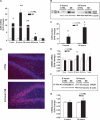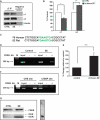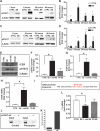BDNF selectively regulates GABAA receptor transcription by activation of the JAK/STAT pathway
- PMID: 18922788
- PMCID: PMC2651003
- DOI: 10.1126/scisignal.1162396
BDNF selectively regulates GABAA receptor transcription by activation of the JAK/STAT pathway
Abstract
The gamma-aminobutyric acid (GABA) type A receptor (GABA(A)R) is the major inhibitory neurotransmitter receptor in the brain. Its multiple subunits show regional, developmental, and disease-related plasticity of expression; however, the regulatory networks controlling GABA(A)R subunit expression remain poorly understood. We report that the seizure-induced decrease in GABA(A)R alpha1 subunit expression associated with epilepsy is mediated by the Janus kinase (JAK)/signal transducer and activator of transcription (STAT) pathway regulated by brain-derived neurotrophic factor (BDNF). BDNF- and seizure-dependent phosphorylation of STAT3 cause the adenosine 3',5'-monophosphate (cAMP) response element-binding protein (CREB) family member ICER (inducible cAMP early repressor) to bind with phosphorylated CREB at the Gabra1:CRE site. JAK/STAT pathway inhibition prevents the seizure-induced decrease in GABA(A)R alpha1 abundance in vivo and, given that BDNF is known to increase the abundance of GABA(A)R alpha4 in a JAK/STAT-independent manner, indicates that BDNF acts through at least two distinct pathways to influence GABA(A)R-dependent synaptic inhibition.
Figures






Similar articles
-
Evidence for a non-canonical JAK/STAT signaling pathway in the synthesis of the brain's major ion channels and neurotransmitter receptors.BMC Genomics. 2019 Aug 28;20(1):677. doi: 10.1186/s12864-019-6033-2. BMC Genomics. 2019. PMID: 31455240 Free PMC article.
-
Surface expression of GABAA receptors is transcriptionally controlled by the interplay of cAMP-response element-binding protein and its binding partner inducible cAMP early repressor.J Biol Chem. 2008 Apr 4;283(14):9328-40. doi: 10.1074/jbc.M705110200. Epub 2008 Jan 7. J Biol Chem. 2008. PMID: 18180303 Free PMC article.
-
JAK/STAT pathway regulation of GABAA receptor expression after differing severities of experimental TBI.Exp Neurol. 2015 Sep;271:445-56. doi: 10.1016/j.expneurol.2015.07.001. Epub 2015 Jul 11. Exp Neurol. 2015. PMID: 26172316 Free PMC article.
-
Molecular pathways controlling inhibitory receptor expression.Epilepsia. 2012 Dec;53 Suppl 9(0 9):71-8. doi: 10.1111/epi.12036. Epilepsia. 2012. PMID: 23216580 Free PMC article. Review.
-
Regulation of GABAA Receptor Gene Expression and Epilepsy.In: Noebels JL, Avoli M, Rogawski MA, Olsen RW, Delgado-Escueta AV, editors. Jasper's Basic Mechanisms of the Epilepsies [Internet]. 4th edition. Bethesda (MD): National Center for Biotechnology Information (US); 2012. In: Noebels JL, Avoli M, Rogawski MA, Olsen RW, Delgado-Escueta AV, editors. Jasper's Basic Mechanisms of the Epilepsies [Internet]. 4th edition. Bethesda (MD): National Center for Biotechnology Information (US); 2012. PMID: 22787609 Free Books & Documents. Review.
Cited by
-
Conditioned-medium of stem cells from human exfoliated deciduous teeth prevent apoptosis of neural progenitors.Saudi Dent J. 2022 Nov;34(7):565-571. doi: 10.1016/j.sdentj.2022.08.005. Epub 2022 Aug 23. Saudi Dent J. 2022. PMID: 36267534 Free PMC article.
-
Postnatal development of brain-derived neurotrophic factor (BDNF) and tyrosine protein kinase B (TrkB) receptor immunoreactivity in multiple brain stem respiratory-related nuclei of the rat.J Comp Neurol. 2013 Jan 1;521(1):109-29. doi: 10.1002/cne.23164. J Comp Neurol. 2013. PMID: 22678720 Free PMC article.
-
A systems approach identifies Enhancer of Zeste Homolog 2 (EZH2) as a protective factor in epilepsy.PLoS One. 2019 Dec 31;14(12):e0226733. doi: 10.1371/journal.pone.0226733. eCollection 2019. PLoS One. 2019. PMID: 31891591 Free PMC article.
-
Inducible cAMP early repressor (ICER) and brain functions.Mol Neurobiol. 2009 Aug;40(1):73-86. doi: 10.1007/s12035-009-8072-1. Epub 2009 May 13. Mol Neurobiol. 2009. PMID: 19434522 Free PMC article. Review.
-
Differential regulation of synaptic and extrasynaptic α4 GABA(A) receptor populations by protein kinase A and protein kinase C in cultured cortical neurons.Neuropharmacology. 2016 Jun;105:124-132. doi: 10.1016/j.neuropharm.2016.01.009. Epub 2016 Jan 6. Neuropharmacology. 2016. PMID: 26767953 Free PMC article.
References
-
- Rudolph U, Mohler H. GABA-based therapeutic approaches: GABAA receptor sub-type functions. Curr. Opin. Pharmacol. 2006;6:18–23. - PubMed
-
- Sieghart W. Structure, pharmacology, and function of GABAA receptor subtypes. Adv. Pharmacol. 2006;54:231–263. - PubMed
-
- Brooks-Kayal AR, Shumate MD, Jin H, Rikhter TY, Kelly ME, Coulter DA. gamma-Aminobutyric acid(A) receptor subunit expression predicts functional changes in hippocampal dentate granule cells during postnatal development. J. Neurochem. 2001;77:1266–1278. - PubMed
-
- Brooks-Kayal AR, Jin H, Price M, Dichter MA. Developmental expression of GABA(A) receptor subunit mRNAs in individual hippocampal neurons in vitro and in vivo. J. Neurochem. 1998;70:1017–1028. - PubMed
-
- Mohler H. Molecular recognition of cognitive functions and developmental plasticity: Impact of GABA(A) receptors. J. Neurochem. 2007;102:1–12. - PubMed
MeSH terms
Substances
Grants and funding
LinkOut - more resources
Full Text Sources
Miscellaneous

